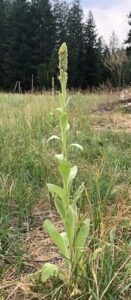This time of year many people are busy harvesting, canning and preparing their fruit and vegetables for the long winter ahead. This probably has been going on for a few months as different fruits and vegetables are ready at different times.
Again this year, I have been harvesting and preparing different wild plants and herbs making healing oils, poultices, teas and tinctures. This is my first time making tinctures and I’m excited to have them in my cupboard ready to try when needed. The three I focused on this year were Elderflower, St. John’s Wort and Mullein but certainly didn’t forget about the many others that I have around. These wild plants have been used for centuries as herbal remedies. Even so, there is still a lot to learn about them as medicine as the scientific world hasn’t caught up.
This is the first year I’ve harvested Mullein. You can use all of this plant, the flowers, leaves and roots. You can use it fresh or dried. You can make a tincture, oil, tea, use it as a poultice, and even smoke it. Some of the first things I learned about it are how it is supposed to help heal the lungs especially during wildfire season when the air we breathe is full of smoke and particulates like ash. Ear aches are said to be eased using warmed mullein oil. A tincture made from the fresh root can be used for structural issues, especially back pain.
According to rxlist.com Mullein is used for cough, whooping cough, tuberculosis, bronchitis, hoarseness, pneumonia, earaches, colds, chills, flu, swine flu, fever, allergies, tonsillitis, and sore throat. Other uses include asthma, diarrhea, colic, gastrointestinal bleeding, migraines, joint pain, and gout. It is also used as a sedative and as a diuretic to increase urine output. Mullein is applied to the skin for wounds, burns, hemorrhoids, bruises, frostbite, and skin infections (cellulitis). The leaves are used topically to soften and protect the skin.
Of course it’s always important to thoroughly research all herb uses, possible side effects and risks. Because these plants are not made, tested, and approved in a laboratory there is not always the scientific information available. When using the internet for research, be sure to use reputable sources such as Rosalee de la Forêt who is a registered Herbalist or Juliet Blankespoor who has a degree in Botany and is the founder of the Chestnut School of Herbal Medicine.
Learning about all the wild herbs that grow around us and have been used as herbal remedies for centuries is fun and grounding. I can forage for arnica, comfrey, common mallow, dandelion, elderberry, lamb’s quarters, lavender, mullein, plantain, purslane, and yarrow right in my own yard, and I probably missed some! It’s great to know I have these healing herbs and plants at my fingertips. I love natural remedies and, of course, that includes massage which can amazingly help our bodies and minds.

